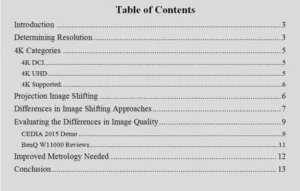Insight Media has released its latest white paper titled Understanding 4K Resolution in Projection Systems. It discusses the changes that are occurring with regards to defining resolution in projection systems.
This is being driven by the wider adoption of so-called “image shifting” techniques which can increase the displayed pixels on the screen – which are higher than the native resolution of the projection engine. This white paper explores the technologies used in image shifting as well as the performance of them. It also defines categories for better evaluation of these products.
For this paper, we defined resolution categories with definitions that focus on what can be resolved ON-SCREEN, which we think is the correct way to evaluate and measure projector resolution. The categories are:
- 4K DCI (4096×2160): accepts 1080p or 2160p content and displays 8.8M pixels on-screen with or without an image shifting optic.
- 4K UHD (3840×2160): accepts 1080p or 2160p content and displays 8.3M pixels on-screen with or without an image shifting optic
- 4K Supported: accepts 1080p or 2160p content and displays around 4M pixels on-screen using an image shifting optic
There are noticeable differences between projections in different classes and even within the same class – most determined by the algorithms used. To dig deeper into this topic, please download the white paper (registration required) – click HERE.

